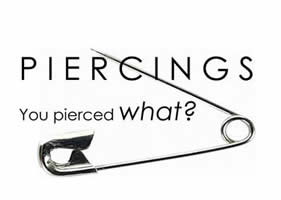September 2010
Body ornamentation involving piercing, tattooing, and other methods has become increasingly popular over the last decade. While generally uncomplicated and straightforward, it is important to recognize that all of these techniques carry risks. They also result in permanent results, which mean they cannot be completely removed or hidden if you change your mind in the future. Let’s review some of the more common complications of piercing.
Piercing and Studs
Piercing involves pushing a sharp object completely through a body part. Studs are commonly used on the face and upper back. These are metal objects embedded in the skin rather than stuck through the body part. For ease of discussion these will be addressed together. Many body parts can be pierced, but the most common are the ears (both the lobes and the upper part of the ear, the pinna), lips, tongue, eyebrow, navel, breasts and genitals.
Your Skin: Protection? Or Route to Infection?
Our skin protects us from infection, and because a rather large hole is made in the skin during piercing, bacteria that normally live on the surface of the skin may enter the wound. Most of these will not set up housekeeping in the wound, but some, including Staph and Strep as well as the more worrisome MRSA (methicillin resistant Staphylococcus aureus) can cause severe, life threatening infections. There have been cases of severe infection of the valves of the heart from introduction of bacteria into the blood stream during piercing. Puncture wounds made by studs can brew some pretty nasty bacteria because there is no oxygen at the bottom of the hole. Think tetanus and gangrene.
Ears:
The pinna of the ear is made up of skin over cartilage. Because cartilage does not have a great blood supply it does not heal well at all. This is the reason wrestlers must wear head protection. Cauliflower ear, where the pinna is injured by blood getting between the skin and the cartilage can lead to severe deformity of the ear. If infection gets into the area of the pinna it is a medical emergency requiring the services of an ear specialist, and not infrequently ending up requiring surgery.
Mouth, Lips, Cheek, Tongue:
If I had to choose between a dog bite and a human bite I would always chose the dog. Why? Because the human mouth is teeming with nasty bacteria that can set up some pretty awful infections. Oral piercings have, however, been particularly popular recently. It seems like everyone has a bar in their tongue these days. In addition to the obvious issues of pain, infection, and speech impairment, tongue piercings are known as a dentist’s best friend because they are notorious for causing damage to teeth. They have also been associated with permanent splitting of the tongue. Lip piercings can leak saliva and can also cause dental problems, though not as commonly as tongue piercings. They have been associated with some of the absolute worst morning mouth you have ever smelled.
Below the Waist:
Waist down piercings are fraught with their own problems. The most commonly infected piercing is the navel. Up to 20% of navel piercings become infected, some with some pretty unusual bugs. Genital piercings can become infected as well and jewelry can be pulled out during sex. They can pull through and tear this rather sensitive tissue which can require surgical repair and result in significant scarring and impaired sexual function as well as urinary complications.
A Word About Scarring:
Most piercings, except perhaps the ear lobe, will leave telltale scars behind when they are removed. Some unlucky folks form keloid in scars. For them, these scars can be quite disfiguring and permanent. Especially with the increasing use of herbal supplements, some of which can impact the clotting ability of the blood, it is not uncommon for people to develop large bruises or even hematomas (a localized collection of blood that can be very painful).
Self Defense:
What can you do to prevent these problems? Number one is, NEVER go to an unlicensed person for a piercing. You wouldn’t think of going to someone that doesn’t have a medical license for a medical procedure. Piercing is a medical procedure. Make sure the person you chose to perform this procedure has received adequate training and is licensed by the state board. If you know you are a carrier of MRSA think twice or maybe even three times before getting pierced. Although MRSA can live quite happily on the surface of your skin without causing any trouble, once MRSA gets under your skin it can wreak havoc. If you have a congenital heart defect, ask your doctor about the wisdom of piercing in your particular case. And follow the instructions given to you at the time of the piercing for cleansing the area to the tee.
Below are some web sites where you can get more information about what is involved in licensure for piercing and the history of piercing.

![]()


